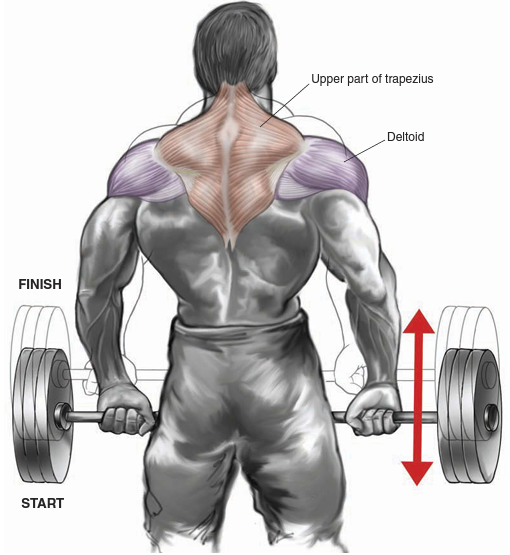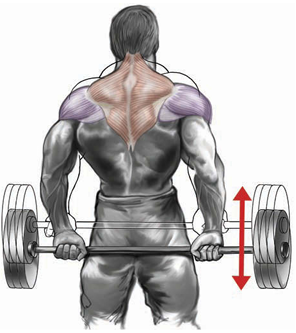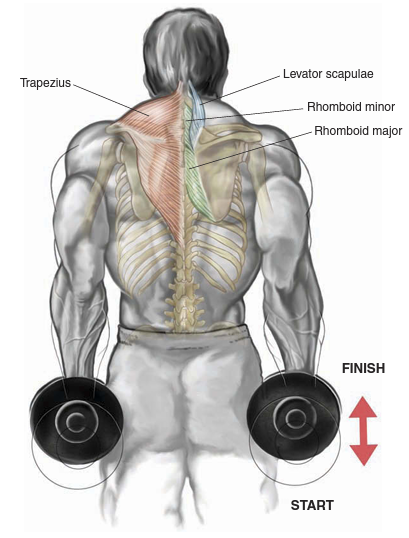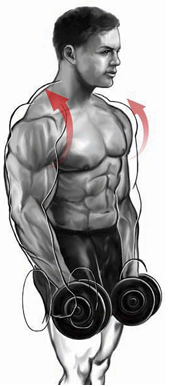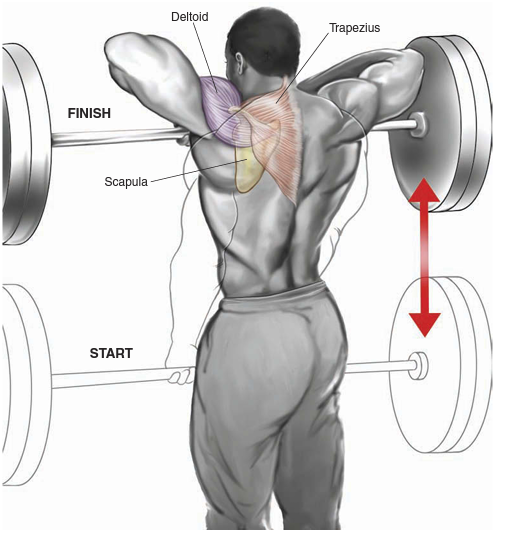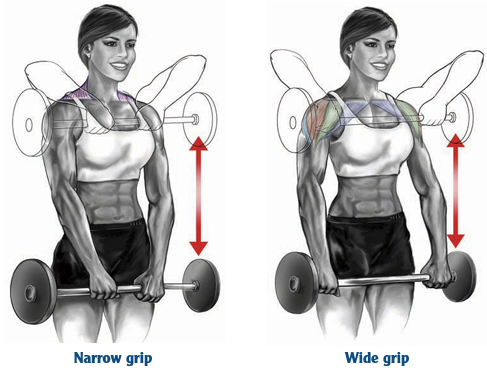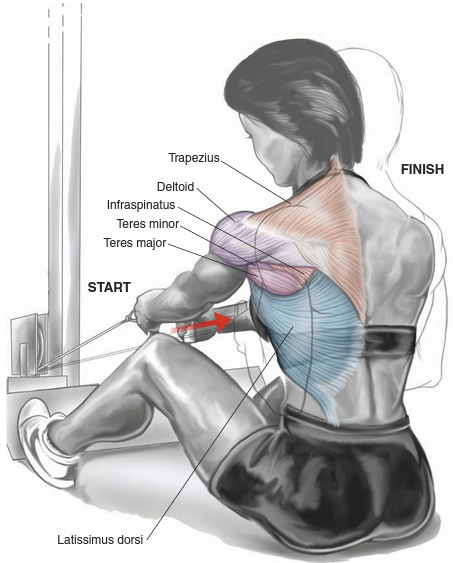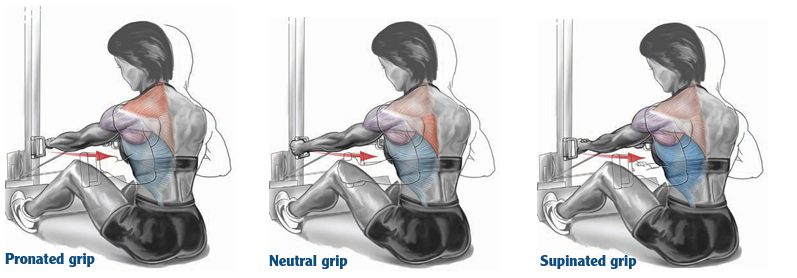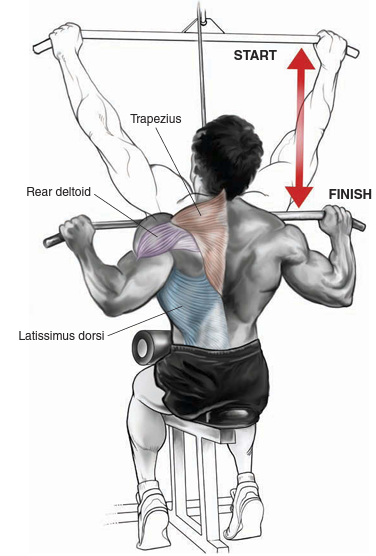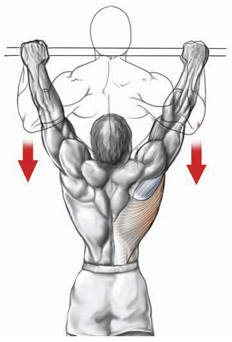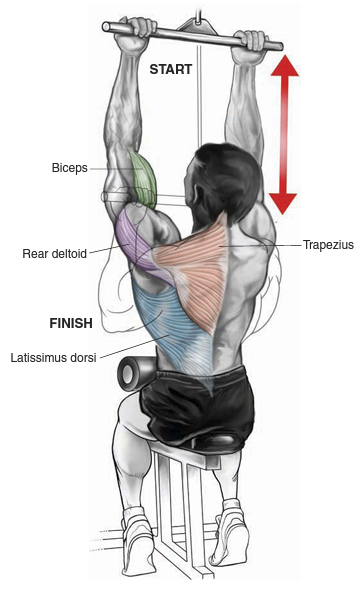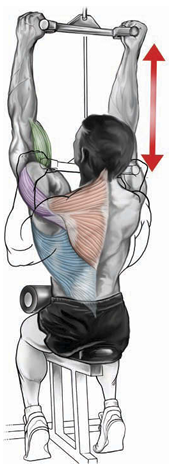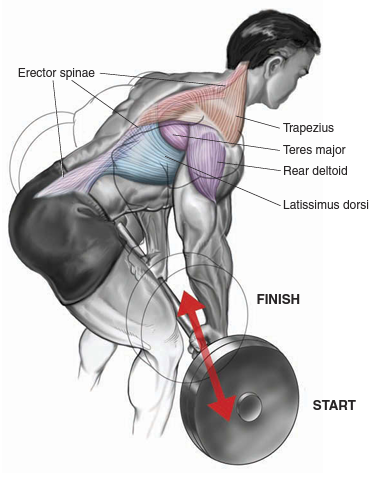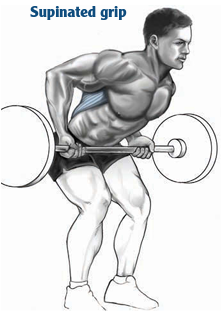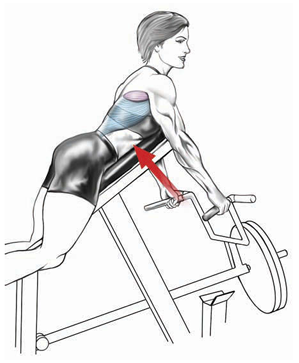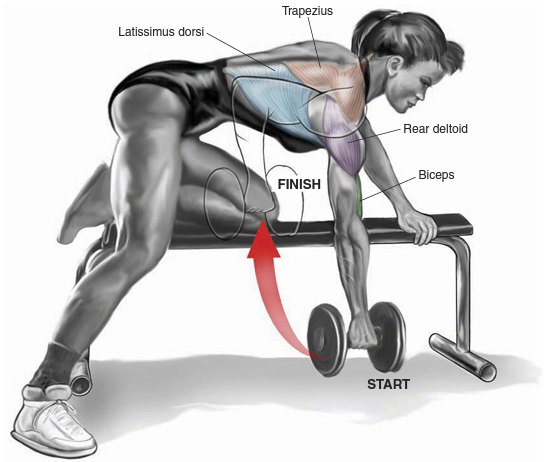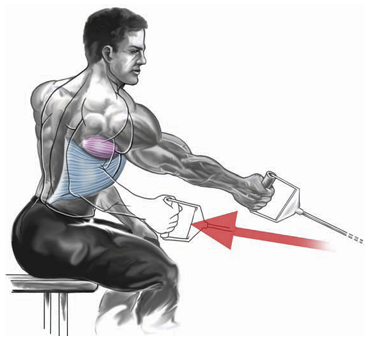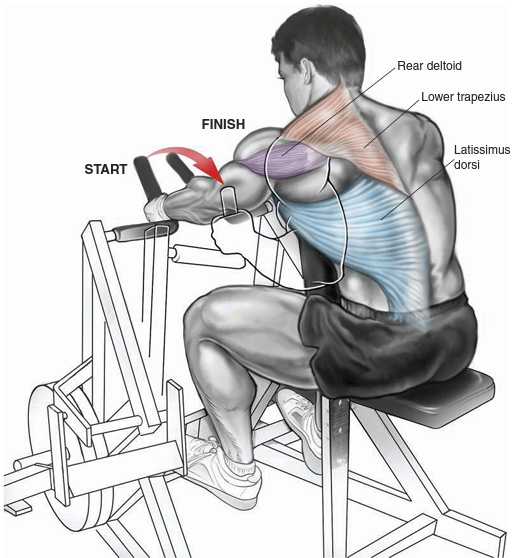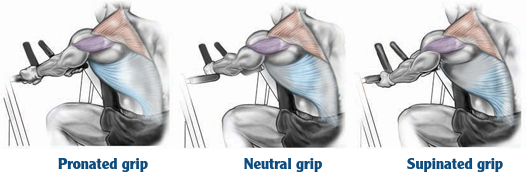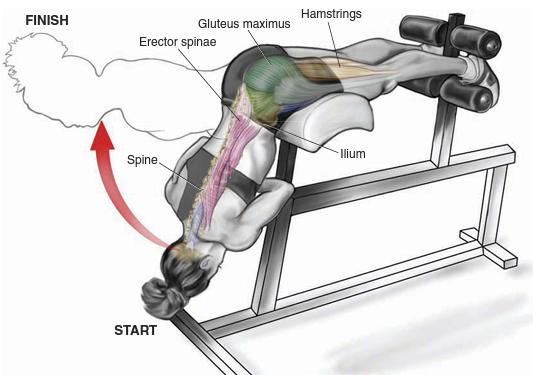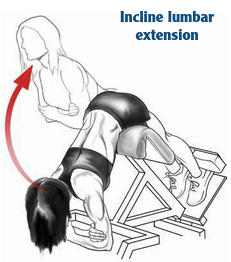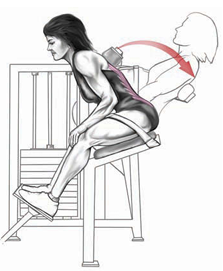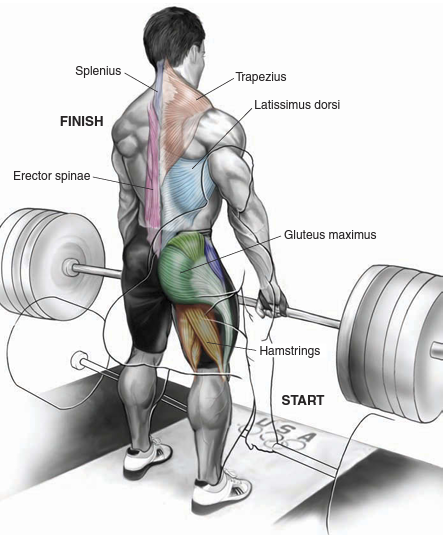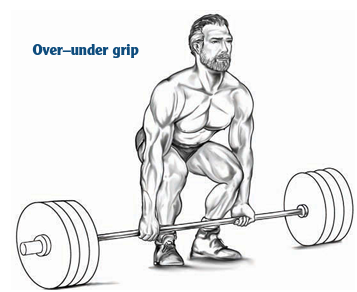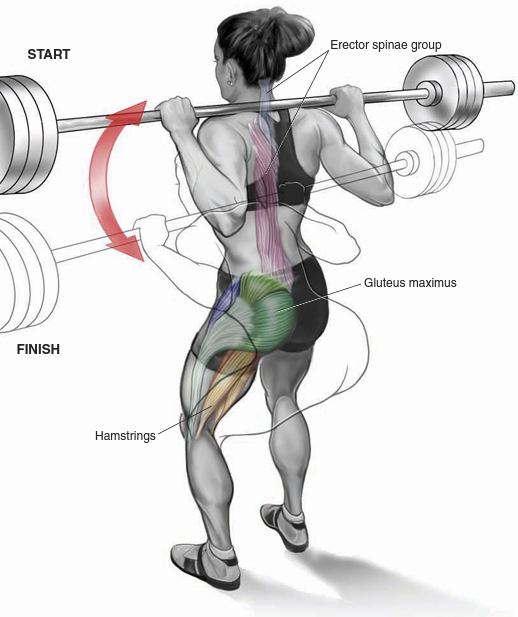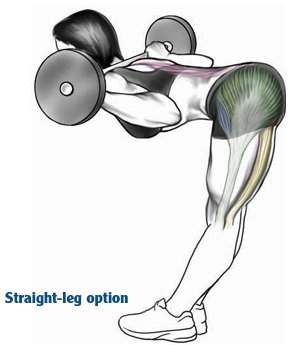Back
Barbell Shrug
Execution
1. Hold a barbell at arms’ length in front of the thighs, using an overhand shoulder-width grip.
2. Keeping arms stiff, shrug your shoulders as high as possible, pulling the bar vertically upward.
3. Lower the bar slowly down to the start position, stretching the trapezius.
Muscles Involved
Primary: Trapezius (upper and middle fi bers).
Secondary: Levator scapulae, deltoid, erector spinae, forearms.
Anatomic Focus
Hand spacing: A shoulder-width or narrower grip on the bar emphasizes the trapezius. A wider grip works the deltoid as well.
Trajectory: Lift the bar straight up and down. Do not roll or rotate the shoulders.
Body position: Performing the shrug while standing vertically upright hits the muscle centrally. Tilting the torso slightly backward at the waist targets the upper trapezius in the neck, whereas leaning slightly forward hits the midsection of the muscle behind the shoulders.
Range of motion: The higher the bar is raised, the harder the trapezius works.
VARIATIONS
Rear Shrug
Performing the exercise with the barbell behind your hips causes scapular retraction, pulling the shoulders backward to emphasize the middle fibers of the trapezius.
Additional variation:
Machine shrug: This affords a choice of grips—pronated (thumbs pointing in) and neutral (thumbs pointing forward). A neutral grip (thumbs pointing forward) emphasizes the upper trapezius in the neck, whereas a pronated grip (thumbs pointing in) targets the middle trapezius in the back.
Dumbbell Shrug
Execution
1. Stand upright with a dumbbell in each hand, hands hanging at your sides.
2. Keeping arms straight, shrug your shoulders upward as high as possible.
3. Lower the dumbbells back down.
Muscles Involved
Primary: Trapezius (upper and middle fi bers).
Secondary: Levator scapulae, deltoid, erector spinae, forearms.
Anatomic Focus
Grip: A neutral grip (thumbs pointing forward) emphasizes the upper trapezius in the neck, whereas a pronated grip (thumbs pointing in) targets the middle trapezius in the back.
Body position: Tilting your torso slightly backward at the waist targets the upper trapezius, whereas leaning slightly forward hits the muscle lower down the neck. Performing the shrug while standing vertically upright hits the upper and middle sections of the trapezius muscle.
Range of motion: The higher the weight is raised, the harder the trapezius works. The farther the dumbbells are lowered, the greater the stretch at the bottom.
VARIATION
Retracting Shrug
Begin with the dumbbells in front, using a pronated grip. Squeeze shoulder blades together during the shrug, fi nishing with the dumbbells at your sides in a neutral grip. The dumbbells are lifted upward (scapular elevation),working the upper traps, and backward (scapular retraction), working the middle section of the trapezius.
Barbell Upright Row
Execution
1. Hold a barbell at arms’ length, using an overhand shoulder-width grip.
2. Pull the bar vertically upward until it reaches your chin, raising the elbows as high as possible.
3. Lower the bar slowly down to the arms’ extended position. Muscles Involved Primary: Trapezius, deltoid. Secondary: Levator scapulae, erector spinae, forearms.
Anatomic Focus
Hand spacing: A shoulder-width or narrower grip on the bar emphasizes the trapezius. A wider grip works the deltoid as well.
Body position: Performing the row while standing vertically upright hits the trapezius centrally. Tilting your torso slightly backward at the waist targets the upper trapezius, whereas leaning slightly forward hits the muscle lower down the neck.
Trajectory: To emphasize the trapezius (not the deltoid), raise the bar close to your body during the exercise.
Range of motion: The higher the bar is raised, the harder the trapezius works but the greater the risk of shoulder-impingement pain.
VARIATIONS
Cable upright row: Using a straight bar attached to the low pulley of a cable machine provides a steady resistance throughout the movement.
Machine upright row: Using a Smith machine provides a single plane of vertical motion that may help focus your effort.
Seated Cable Row
Execution
1. Grab the handles with arms extended in front.
2. Pull the handles high toward your chest, keeping your spine straight.
3. Return the handles to the start position.
Muscles Involved
Primary: Trapezius (middle and lower fibers), latissimus dorsi.
Secondary: Rhomboids, rear deltoid.
Anatomic Focus
Hand spacing: Spacing your hands farther apart will target the outer trapezius, whereas placing your hands closer together will focus on the inner portion of the trapezius.
Grip: A pronated (overhand) grip tends to target the upper and middle trapezius, whereas a neutral (thumbs up) grip hits the middle and lower trapezius. A supinated (underhand) grip switches the focus to the latissimus dorsi.
Trajectory: To target the trapezius, pull the handles or bar through a high trajectory toward the chest; a low trajectory toward the abdomen works the latissimus dorsi.
Body position: Keep your back straight and torso upright.
Range of motion: Pull your elbows back and high as far as possible, and squeeze the shoulder blades together to maximize muscle contraction.
VARIATION
Machine row: See description of this exercise here.
Wide-Grip Pulldown
Execution
1. Take an overhand grip on the bar with hands 6 inches (15 cm) wider than shoulder width.
2. Pull the bar down to the upper chest, squeezing your lats.
3. Return the bar to the start position overhead.
Muscles Involved
Primary: Latissimus dorsi (outer section).
Secondary: Rear deltoid, lower trapezius, rhomboids.
Anatomic Focus
Hand spacing: As the hand spacing gets wider, the focus shifts to the outermost section of the latissimus dorsi under the armpit. This portion of the muscle creates width across the back.
Grip: An overhand (pronated) grip works best for the wide-grip pulldown. Grasping the angled section at the outer edges of the handlebar affords a better contraction in the lats.
Trajectory: When your torso is upright, the bar is pulled vertically downward using shoulder adduction, which emphasizes the outer lats. Leaning your torso back about 30 degrees from the vertical plane creates a trajectory that uses shoulder extension, which emphasizes the inner lower lats.
Range of motion: To maximize range of motion, stretch the lats at the top position, and squeeze the lats at the bottom by pulling the elbows down and back as far as possible.
VARIATIONS
Wide-Grip Pull-Up
Pull-ups are similar to pulldowns, except that resistance is provided by your own body weight. Pull-ups primarily use shoulder adduction and therefore tend to work the outer lats, generating width across the back.
Additional variations:
Handlebar variations: The angled ends of a wide-grip pulldown bar offer several advantages over a straight bar: improved trajectory, less stress through the wrist joint, and a few extra inches of motion before the bar touches the chest.
Behind-the-neck pulldown: Pulling the bar down behind the neck is a less favorable trajectory that can cause injury to the shoulder joint.
Close-Grip Pulldown
Execution
1. Take an underhand (reverse) grip on the bar, with hands spaced 6 to 12 inches (15 to 30 cm) apart.
2. Pull the bar down to the upper chest, squeezing your lats.
3. Return the bar to the start position, arms extended overhead.
Muscles Involved
Primary: Latissimus dorsi (inner section).
Secondary: Lower trapezius, rhomboids, rear deltoid, biceps.
Anatomic Focus
Hand spacing: As the hand spacing gets narrower, the focus shifts to the innermost section of the latissimus dorsi, generating thickness and depth in the middle back.
Grip: The close-grip pulldown uses shoulder extension rather than adduction. The arms are pulled down and backward, which emphasizes the inner lower sections of the lats.
Trajectory: Leaning your torso back about 30 degrees from the vertical plane improves trajectory and helps isolate the latissimus dorsi muscle. Do not lean back too far or pull the weight down with momentum.
Range of motion: Stretch the lats at the top, and squeeze the lats at the bottom by pulling the elbows down and back as far as possible.
VARIATIONS
Handlebar Variation
Handlebar attachments allow a neutral grip (palms facing together). This hand position is midway between a pronated (overhand) grip and a supinated (underhand) grip. An overhand grip targets the outer lats, an underhand grip isolates the inner lats, and a neutral grip hits the muscle centrally.
Additional variation:
Close-grip pull-up: Pull-ups are similar to pulldowns except that resistance provided by your own body weight is not easily adjusted.
Barbell Row
Execution
1. Taking an overhand shoulder-width grip on the barbell, bend your torso forward at an angle of 45 degrees to the floor.
2. Pull the bar vertically upward to touch the lower chest, keeping your spine straight and knees slightly bent.
3. Lower the bar down to the arms’ extended position.
Muscles Involved
Primary: Latissimus dorsi.
Secondary: Erector spinae, trapezius, rhomboids, rear deltoid.
Anatomic Focus
Hand spacing: Spacing your hands shoulder-width apart or closer targets the central inner section of the lats, whereas a wider grip targets the outer lats.
Grip: An underhand (supinated) grip on the bar facilitates a closer hand spacing, emphasizing shoulder extension and targeting the central inner section of the lats. A greater contribution from the biceps with an underhand grip provides added strength during the row.
Trajectory: Pulling the bar up higher toward the chest targets the upper latissimus and trapezius. Pulling the bar through a lower trajectory to touch the abdomen targets the lower lats.
Body position: Keep your spine straight. The lower back should never be rounded in an attempt to lower the bar farther, because this will provoke injury.
VARIATION
T-Bar Row This variation requires less effort to stabilize body position during the row, because one end of the bar pivots at a fi xed point on the fl oor. Stand facing the loaded end with feet positioned on either side of the bar. With your spine straight and knees slightly bent, lift the loaded end using the T-bar attachment. Some row apparatus provide an inclined chest pad to support the torso and minimize load across the lower spine.
Dumbbell Row
Execution
1. Grasp a dumbbell with palm facing in. Rest the opposite hand and knee on a bench, keeping your spine straight and just above parallel to the fl oor.
2. Pull the dumbbell vertically upward alongside your torso, raising the elbow as high as possible.
3. Lower the dumbbell down to the start position.
Muscles Involved
Primary: Latissimus dorsi.
Secondary: Trapezius, rhomboids, rear deltoid, erector spinae, biceps.
Anatomic Focus
Grip: A neutral grip with the dumbbell parallel to the torso works best. The dumbbell will tend to jam against your torso if a pronated or supinated grip is attempted.
Trajectory: Pulling the dumbbell toward the chest works the upper latissimus and lower trapezius. Raising the dumbbell through a lower trajectory toward the abdomen targets the lower lats.
Range of motion: Maximize the range of motion by stretching the latissimus at the bottom and raising the elbow as high as possible at the top.
Body position: With your torso supported on the bench, stress through the spine is reduced.
VARIATION
One-Arm Seated Cable Row
Perform a seated low-pulley cable row by grabbing the handle with one hand at a time. Rowing one arm at a time allows the elbow to be pulled back farther, thereby maximizing muscle contraction in the lats.
Machine Row
Execution
1. Grab the handles with arms extended in front, supporting your torso against the chest pad.
2. Pull the handles toward your upper abdomen, keeping your spine straight.
3. Return the weight to the start position.
Muscles Involved
Primary: Latissimus dorsi.
Secondary: Trapezius, rhomboids, rear deltoid.
Anatomic Focus
Hand spacing: Spacing your hands farther apart will target the outer lats, whereas spacing your hands closer together will isolate the inner lats.
Grip: A pronated (overhand) grip tends to target the upper and outer lats, a neutral (thumbs up) grip hits the central section of the back, and a supinated (underhand) grip works the lower lats. As the grip changes from pronation to neutral to supination, the elbows move progressively closer to the sides of your body.
Trajectory: Pulling the handle through a high trajectory toward the chest targets the upper latissimus and trapezius, whereas a lower trajectory toward the abdomen targets the lower lats. Adjust the seat height to change trajectory. Raising the seat creates a low trajectory, and lowering the seat provides a high trajectory.
Range of motion: Pull your elbows as far back as possible and squeeze the shoulder blades together to maximize muscle contraction.
Body position: With the torso supported against a chest pad, load across the spine is reduced.
VARIATION
Seated cable row:
Lumbar Extension
Execution
1. Lie facedown with hips supported on the bench and ankles secured under the pads.
2. Begin with your torso hanging down, bent 90 degrees at the waist.
3. Raise your body up until your torso is just above parallel to the fl oor.
Muscles Involved
Primary: Erector spinae.
Secondary: Latissimus dorsi, gluteals, hamstrings.
Anatomic Focus
Hand position: Hands may be interlocked behind your lower back or folded across your chest.
Resistance: Add resistance by holding a weight plate against the front of your chest.
Trajectory: You can perform the movement at an incline angle (see Variations section).
Range of motion: Your torso should move up and down through an arc of about 90 degrees. Avoid hyperextending your spine. The erector muscles work to stabilize and straighten the spine, while the glutes and hamstrings generate hip extension during this movement.
VARIATIONS
Incline Lumbar Extension
Performing the movement at an incline with the hips supported high and the ankles closer to the f l oor makes the exercise easier. The disadvantage is that the inclined position shifts the focus away from the lumbar muscles onto the buttocks and hamstrings.
Machine lumbar extension
You can also perform the exercise while seated on a lumbar extension machine that provides variable resistance. To avoid injury, do not fl ex the spine too far forward or extend too far backward.
Deadlift
Execution
1. Take a shoulder-width overhand grip on the barbell with arms extended, and squat down, bending the knees and hips.
2. Keeping your spine straight and elbows stiff, stand upright, lifting the bar upward to hip level.
3. Slowly lower the bar back to the fl oor. Muscles Involved Primary: Erector spinae, gluteals, hamstrings. Secondary: Trapezius, latissimus dorsi, quadriceps, forearms.
Anatomic Focus
Hand spacing: Hands should be spaced shoulder-width apart so that the arms hang vertical and hands pass along the outer thighs.
Grip: An over–under grip with one palm facing forward and the other facing back prevents the bar from rolling.
Stance: Position feet directly below the hips, with toes pointing straight ahead.
Trajectory: The bar should travel straight up and down, close to the body.
Range of motion: The barbell is lifted from the fl oor up to the top of the thighs, with arms extended and elbows kept stiff. During this movement, the erector spinae muscles work to stabilize and straighten the spine while the glutes and hamstrings generate hip extension. Keep the spine straight throughout the movement; do not round the lower back forward or extend the spine too far backward.
VARIATIONS
Stiff-leg deadlift: Performing the deadlift with the legs stiff shifts the focus from the lower back to the buttocks and hamstrings (see the stiff-leg deadlift on page 150). Sumo-style deadlift: Performing the lift with a wide stance places the emphasis on the thigh muscles. Cable pull-through: Stand facing away from a low pulley and perform the lift using a short bar with the cable passing between your legs.
Good Morning Lift
Execution
1. Stand upright with a barbell resting across your shoulders.
2. Keeping your spine straight and knees stiff (straight or slightly bent), bend forward at the waist until your torso is just above parallel to the floor.
3. Raise your torso back to the upright position.
Muscles Involved
Primary: Erector spinae.
Secondary: Latissimus dorsi, gluteals, hamstrings.
Anatomic Focus
Grip: Place hands slightly wider than shoulder-width apart using an overhand grip to secure the barbell across your shoulders.
Trajectory: A slight bend in the knees helps execution.
Range of motion: Your torso should move up and down through an arc of about 90 degrees. Keep your spine straight and head up, and avoid bending your torso below parallel to the fl oor. During this movement, the erector spinae muscles work to stabilize and straighten the spine while the glutes and hamstrings generate hip extension.
VARIATION
Machine Lift
You can perform this while seated with resistance provided by a pad across the upper back.
From book: Bodybuilding anatomy, Nick Evans, 2007
Related Posts
-
 Legs
No Comments | Jan 9, 2015
Legs
No Comments | Jan 9, 2015 -
 Abdominals
No Comments | Jan 13, 2015
Abdominals
No Comments | Jan 13, 2015 -
 Chest
No Comments | Jan 9, 2015
Chest
No Comments | Jan 9, 2015 -
 Arms
No Comments | Dec 29, 2014
Arms
No Comments | Dec 29, 2014

